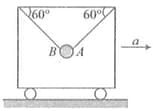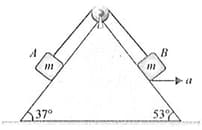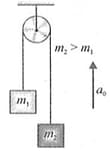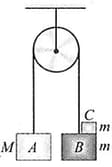B M Sharma Solutions for Chapter: Newton's Laws of Motion (Without Friction), Exercise 50: CONCEPT APPLICATION EXERCISE 6.5
B M Sharma Physics Solutions for Exercise - B M Sharma Solutions for Chapter: Newton's Laws of Motion (Without Friction), Exercise 50: CONCEPT APPLICATION EXERCISE 6.5
Attempt the practice questions on Chapter 6: Newton's Laws of Motion (Without Friction), Exercise 50: CONCEPT APPLICATION EXERCISE 6.5 with hints and solutions to strengthen your understanding. PHYSICS For Joint Entrance Examination JEE (Advanced) Mechanics I solutions are prepared by Experienced Embibe Experts.
Questions from B M Sharma Solutions for Chapter: Newton's Laws of Motion (Without Friction), Exercise 50: CONCEPT APPLICATION EXERCISE 6.5 with Hints & Solutions
Two trolleys and are moving with accelerations and , respectively, in the same direction. To an observer in trolley , Find the magnitude of the pseudo force acting on a block of mass on trolley .
A steel ball is suspended from the ceiling of an accelerating carriage by means of two cords and . Determine the acceleration of the carriage which will cause the tension in to be twice that in .
Two blocks and of equal masses each are connected by a light thread which passes over a massless pulley as shown. Both the blocks lie on wedge of mass . Assume friction to be absent everywhere and both the blocks to be always in contact with the wedge. The wedge lying over smooth horizontal surface is pulled towards right with constant acceleration ( is acceleration due to gravity).
(i) Find the normal reaction acting on block .
(ii) Find the normal reaction acting on block .
(iii) Find the accelerations of block and block with respect to wedge.
(iv) Find the maximum value of acceleration for which normal reactions acting on the block and block are non-zero.
Assuming that the magnitudes of the acceleration and the acceleration are the same, a person is standing on a weighing machine placed on the floor of an elevator. The elevator starts going up with some acceleration, moves with uniform velocity for a while and finally decelerates to stop. The maximum and the minimum weights recorded are and , find
(a) the true weight of the person and
(b) the magnitude of the acceleration.
In the given figure, the pulley and strings are light. The pulley is suspended in a elevator moving up with acceleration . Find the accelerations of the blocks with respect to elevator.
In the given system, the pulley is light and frictionless; string is also massless. Initially the system is in equilibrium. Now a small block of mass is placed on the block of mass . If block always remains on block , find the normal reaction on due to .





